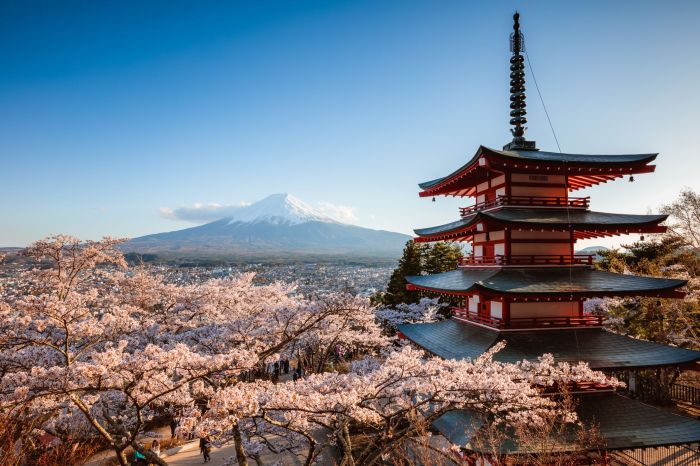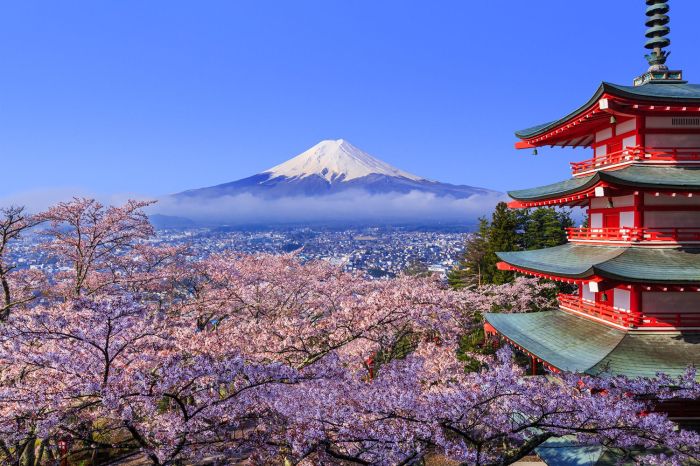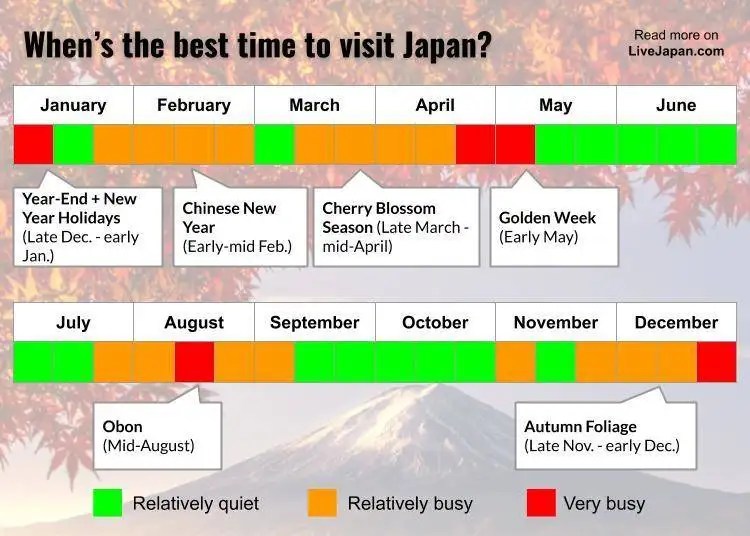Deciding the best time to visit Japan is a journey in itself, where every season unveils its own captivating allure. From the ethereal beauty of cherry blossoms to the vibrant hues of autumn foliage, Japan’s natural wonders dance harmoniously with its rich cultural heritage. Let us guide you through the tapestry of seasons, helping you craft an unforgettable travel experience.
Japan’s distinct seasons offer a kaleidoscope of experiences, each with its unique charm. Spring awakens with the delicate blooms of cherry blossoms, inviting you to witness the celebrated hanami tradition. Summer’s warmth beckons you to explore lush gardens and serene beaches. Autumn paints the land in vibrant hues of red and gold, creating a breathtaking spectacle for nature enthusiasts. Winter transforms the landscape into a snowy wonderland, perfect for cozying up in traditional ryokans or venturing out for winter sports.
Seasonal Variations

Japan experiences four distinct seasons: spring, summer, autumn, and winter. Each season offers unique weather conditions, temperatures, and precipitation, which significantly impact tourism. Here’s a detailed comparison of the seasons in Japan:
| Season | Months | Weather Conditions | ||
|---|---|---|---|---|
| Temperature | Precipitation | Humidity | ||
| Spring | March – May | Mild and pleasant, with temperatures ranging from 10°C to 20°C | Moderate, with occasional showers | Low to moderate |
| Summer | June – August | Hot and humid, with temperatures reaching up to 35°C | High, with frequent rainfall | High |
| Autumn | September – November | Mild and comfortable, with temperatures ranging from 15°C to 25°C | Moderate, with occasional showers | Low to moderate |
| Winter | December – February | Cold and snowy, with temperatures dropping below 0°C | Low, with occasional snowfalls | Low |
Seasonal Activities and Events
The varying seasons in Japan offer a wide range of seasonal activities and events:
- Spring: Cherry blossom viewing (hanami), spring festivals, and hiking
- Summer: Fireworks festivals, summer festivals (matsuri), and beach activities
- Autumn: 紅葉 (koyo) leaf viewing, harvest festivals, and temple visits
- Winter: Skiing, snowboarding, and snow festivals
Cherry Blossom Season
Cherry blossom viewing, known as hanami, is a centuries-old tradition in Japan that celebrates the ephemeral beauty of the cherry blossoms. During this time, people gather under the cherry trees to enjoy picnics, parties, and the stunning pink and white blooms.
Cherry blossom season typically begins in late March in Okinawa and gradually moves northward, reaching Tokyo in late March to early April and Hokkaido in early May. The duration of the season varies depending on the region and weather conditions, but it usually lasts for about two weeks.
Tips for Planning a Trip to Witness the Cherry Blossoms
- Book your flights and accommodations early, as cherry blossom season is a popular time to visit Japan.
- Check the cherry blossom forecast to determine the best time to visit your desired destination.
- Bring a picnic blanket and snacks to enjoy under the cherry trees.
- Be respectful of the trees and other visitors.
li>Consider visiting less popular spots to avoid crowds.
Autumn Foliage Season: Best Time To Visit Japan
Japan’s autumn foliage season is a breathtaking spectacle of vibrant colors that transforms the country’s landscapes into a mesmerizing tapestry. From late September to mid-November, deciduous trees across Japan don hues of gold, crimson, and amber, creating a kaleidoscope of colors that draws visitors from around the world.
Timing and Duration
The timing and duration of the autumn foliage season vary depending on the region and altitude. In general, the foliage begins to change color in late September in the northernmost regions of Hokkaido and progresses southward as the season progresses. It typically reaches its peak in mid-October in most areas, although higher elevations may experience peak foliage earlier or later.
Scenic Drives and Hiking Trails
To fully appreciate the beauty of Japan’s autumn foliage, consider embarking on a scenic drive or hiking trail. Some popular routes include:
- Chubu-Sangaku National Park: This mountainous region offers stunning views of colorful foliage, particularly along the Tateyama Kurobe Alpine Route.
- Nikko National Park: Known for its pristine lakes and ancient temples, Nikko National Park is a picturesque destination for autumn foliage viewing.
- Hakone National Park: This scenic area near Mount Fuji offers breathtaking views of foliage from its numerous hiking trails and hot spring resorts.
Cultural Festivals and Events

Japan’s cultural calendar is brimming with festivals and events that showcase the country’s rich traditions, history, and artistic heritage. These celebrations offer visitors an immersive experience, allowing them to witness vibrant performances, participate in ancient rituals, and savor delectable local cuisine.
Major Festivals and Events, Best time to visit japan
Throughout the year, Japan hosts numerous festivals, each with its unique significance and traditions. Some of the most notable include:
- New Year’s Eve (Omisoka): Celebrated on December 31st, Omisoka marks the end of the old year and the beginning of a new one. It is customary to visit shrines and temples to pray for good fortune and ring in the New Year with fireworks and festivities.
- Setsubun (February 3rd): Setsubun is a festival that marks the transition from winter to spring. People throw roasted soybeans at a demon mask to ward off evil spirits and bring good luck.
- Hinamatsuri (March 3rd): Also known as the Doll Festival, Hinamatsuri is celebrated to honor young girls and their future happiness. Families display elaborate doll displays in their homes, representing the Emperor, Empress, and their court.
- Golden Week (April 29th – May 5th): Golden Week is a series of four national holidays that occur in late April and early May. It is a popular time for travel and outdoor activities.
- Gion Matsuri (July): Held in Kyoto, Gion Matsuri is one of Japan’s most famous festivals. It features a grand procession of floats decorated with elaborate tapestries and lanterns, as well as traditional dances and performances.
- Obon (August 13th – 16th): Obon is a Buddhist festival honoring the spirits of deceased ancestors. Families gather at temples and gravesites to pay their respects and offer prayers.
- Autumn Moon Festival (September): The Autumn Moon Festival, also known as Tsukimi, is a time to celebrate the full moon and the harvest. People gather to admire the moon, eat special moon-viewing dumplings, and compose poems.
Enhance Your Travel Experience
Attending a cultural festival or event in Japan can significantly enhance a travel experience. These celebrations provide a glimpse into the country’s rich traditions, customs, and artistic expressions. They offer opportunities to interact with locals, learn about Japanese history and culture, and create lasting memories. By incorporating festivals and events into an itinerary, travelers can immerse themselves in the vibrant and diverse spirit of Japan.
Weather Considerations

Japan’s climate varies significantly throughout the year and across different regions. The country experiences four distinct seasons: spring, summer, autumn, and winter. Each season brings its unique weather patterns and potential hazards.
Overall, Japan’s climate is temperate, with warm, humid summers and cool, dry winters. However, there are regional variations, with the southern islands having a subtropical climate and the northern islands experiencing colder temperatures.
Average Temperatures and Rainfall
The following table provides average temperatures and rainfall for major cities in Japan during different seasons:
| City | Season | Average Temperature (°C) | Average Rainfall (mm) |
|---|---|---|---|
| Tokyo | Spring (March-May) | 12-20 | 120 |
| Summer (June-August) | 25-35 | 150 | |
| Autumn (September-November) | 15-25 | 100 | |
| Winter (December-February) | 5-12 | 50 | |
| Kyoto | Spring (March-May) | 10-18 | 130 |
| Summer (June-August) | 27-37 | 180 | |
| Autumn (September-November) | 16-26 | 110 | |
| Winter (December-February) | 4-10 | 50 | |
| Osaka | Spring (March-May) | 12-20 | 150 |
| Summer (June-August) | 26-36 | 160 | |
| Autumn (September-November) | 16-26 | 100 | |
| Winter (December-February) | 5-11 | 50 |
Potential Weather Hazards
Japan is prone to several types of weather hazards, including:
- Typhoons: These tropical cyclones can bring strong winds, heavy rainfall, and flooding. They typically occur during the summer and autumn months.
- Earthquakes: Japan is located on the Pacific Ring of Fire and experiences frequent earthquakes. While most are minor, larger earthquakes can cause significant damage and loss of life.
- Tsunamis: These large waves can be generated by earthquakes or underwater landslides. They can cause severe damage and loss of life in coastal areas.
Tips for Packing and Preparation
When packing for a trip to Japan, it’s important to consider the weather conditions you’re likely to encounter. Here are a few tips:
- Layers: Japan’s weather can be unpredictable, so it’s a good idea to pack layers of clothing that you can adjust to changing temperatures.
- Rain gear: Rain is common in Japan, especially during the summer and autumn months. Pack a raincoat or umbrella to stay dry.
- Sunscreen: Japan’s summers can be sunny, so pack sunscreen to protect yourself from the sun’s rays.
- Comfortable shoes: You’ll be doing a lot of walking in Japan, so make sure to pack comfortable shoes.
Crowds and Tourism

Japan experiences significant variations in tourism throughout the year, with certain seasons attracting larger crowds. Peak tourist seasons include spring (March-May) for cherry blossom viewing and autumn (September-November) for vibrant foliage. During these periods, popular destinations like Tokyo, Kyoto, and Osaka can be extremely crowded, resulting in higher prices for accommodations, transportation, and attractions.
For a truly memorable experience, plan your trip to Japan during the cherry blossom season in spring or the vibrant autumn foliage season. If you’re a soccer enthusiast, be sure to visit the iconic Allianz Arena in Munich, Germany, for an unforgettable matchday atmosphere.
Afterward, return to Japan and immerse yourself in its rich culture and breathtaking natural beauty.
To avoid the crowds, consider visiting Japan during the shoulder seasons (April-June and October-November) when the weather is still pleasant, and the crowds are smaller. Alternatively, explore less-visited destinations such as Okinawa, Hokkaido, or the Seto Inland Sea region, which offer unique experiences with fewer tourists.
Booking Accommodations and Transportation in Advance
To secure accommodations and transportation during peak season, it’s highly recommended to book in advance, especially for popular destinations like Tokyo and Kyoto. Consider using online booking platforms or contacting the hotel or transportation provider directly to inquire about availability and rates.
The best time to visit Japan is during the shoulder seasons of spring and autumn, when the weather is mild and the crowds are smaller. If you’re looking for a warm beach destination, consider antalya turkey , which offers stunning beaches, ancient ruins, and delicious Turkish cuisine.
After your trip to Antalya, be sure to return to Japan during the cherry blossom season in April or the autumn foliage season in November for an unforgettable experience.
Special Considerations
To fully enjoy your trip to Japan, it’s important to be aware of special considerations during specific times of the year and cultural customs.
Holidays and school breaks can significantly impact travel plans. Golden Week (late April to early May) and Obon (mid-August) are major holiday periods when many Japanese people travel, leading to increased crowds and higher prices.
If you’re considering a trip to Japan, the best time to visit is during the shoulder seasons (April-May and September-October) when the weather is pleasant and there are fewer tourists. To make your trip even more rewarding, consider using american express gold card benefits such as complimentary airport lounge access, travel insurance, and exclusive dining offers.
This will help you maximize your travel experience and create lasting memories.
Cultural Customs and Etiquette
Japan is known for its unique cultural customs and etiquette. Respecting these customs is essential for a positive travel experience.
- Remove your shoes before entering homes, temples, and some restaurants.
- Avoid talking loudly in public places, especially on public transportation.
- Be mindful of personal space and avoid pushing or shoving.
- Learn basic Japanese phrases like “hello” and “thank you” to show respect.
Summary
Whether you seek the tranquility of cherry blossom viewing, the vibrant energy of festivals, or the serenity of autumn foliage, Japan offers a symphony of experiences throughout the year. By understanding the seasonal variations and special events, you can tailor your trip to perfectly align with your interests and create memories that will last a lifetime.
User Queries
What is the best time to visit Japan for cherry blossoms?
Cherry blossom season typically falls between late March and early April, but the exact timing varies depending on the region.
When is the autumn foliage season in Japan?
Autumn foliage season generally occurs from mid-October to late November, with the peak viewing period around mid-November.
What are some popular cultural festivals in Japan?
Some of the most famous cultural festivals in Japan include the Gion Matsuri in Kyoto, the Nebuta Matsuri in Aomori, and the Yuki Matsuri in Sapporo.
What should I pack for a trip to Japan?
Depending on the season, pack light, breathable clothing for summer, warm layers for winter, and comfortable walking shoes for exploring.
How do I avoid crowds in Japan?
To avoid crowds, consider visiting during the shoulder seasons (April-May and September-October) or exploring less popular destinations.